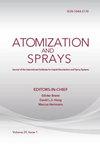正常蒸发和过热条件下氨喷雾的模拟
IF 0.9
4区 工程技术
Q4 ENGINEERING, CHEMICAL
引用次数: 0
摘要
提出了一个预测氨喷雾的三维欧拉-拉格朗日框架,并揭示了其在正常蒸发和过热条件下的演化特征。首先,建立了考虑喷嘴内过热流体行为对喷射速度和喷射角影响的简化边界模型;在蒸发模型中引入了实气液平衡理论,提高了相变的预测精度。采用均匀成核理论的爆炸模型对爆炸过程进行了模拟。然后,对液氨进行了不同条件下的喷雾实验,采用高速扩散背照法和纹影法测量了喷雾过程。然后,将模拟结果与正常蒸发和过热条件下的实验数据进行了验证,结果吻合较好,表明所提出的框架能够准确、高效地模拟氨喷雾的演化和形态。最后,讨论了不同条件下氨喷雾的瞬态演化特性。氨蒸发的重冷却效应使得初始燃料温度对其喷雾渗透和膨胀有显著影响。本文章由计算机程序翻译,如有差异,请以英文原文为准。
SIMULATION OF AMMONIA SPRAY UNDER BOTH NORMAL EVAPORATING AND SUPERHEATED CONDITIONS
A predictive three-dimensional Eulerian−Lagrangian framework for ammonia spray is suggested, and its evolution characteristics under both normal evaporating and superheated conditions are unraveled. First, a simplified boundary model considering the effects of superheated fluid behaviors within the nozzle on the injection velocity and angle was proposed. The real vapor−liquid equilibrium theory is applied in the evaporation model to improve the prediction accuracy of the phase change. An explosion model with the homogenous nucleation theory was used to simulate the burst process. Then, the spray experiment for the liquid ammonia under varied conditions was conducted, and the high-speed diffused back illumination and schlieren approaches were adopted to measure the spray evolutions. Following that, the simulation results were verified against the experimental data under both normal evaporating and superheated conditions, and good agreements indicated that the suggested framework was feasible to accurately and efficiently simulate the evolutions and
morphology of ammonia spray. Finally, the transient evolution characteristics of ammonia spray under various conditions were discussed. The heavy cooling effect of ammonia evaporation makes the initial fuel temperature have a notable effect on its spray penetration and expansion.
求助全文
通过发布文献求助,成功后即可免费获取论文全文。
去求助
来源期刊

Atomization and Sprays
工程技术-材料科学:综合
CiteScore
2.10
自引率
16.70%
发文量
54
审稿时长
1.7 months
期刊介绍:
The application and utilization of sprays is not new, and in modern society, it is extensive enough that almost every industry and household uses some form of sprays. What is new is an increasing scientific interest in atomization - the need to understand the physical structure of liquids under conditions of higher shear rates and interaction with gaseous flow. This need is being met with the publication of Atomization and Sprays, an authoritative, international journal presenting high quality research, applications, and review papers.
 求助内容:
求助内容: 应助结果提醒方式:
应助结果提醒方式:


